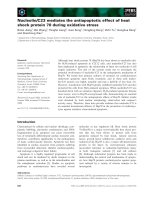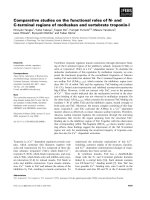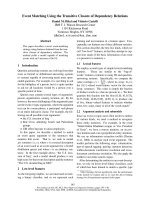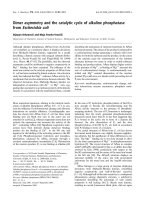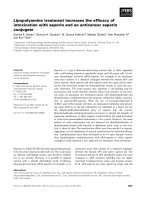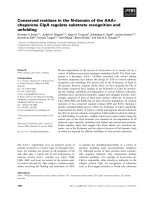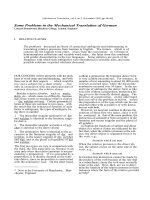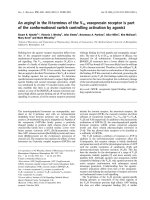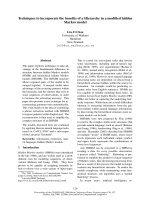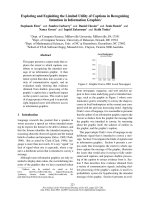Báo cáo khoa học: "TENSE TREES AS THE "FINE STRUCTURE" OF DISCOURSE" ppt
Bạn đang xem bản rút gọn của tài liệu. Xem và tải ngay bản đầy đủ của tài liệu tại đây (887.67 KB, 9 trang )
TENSE TREES
AS
THE "FINE STRUCTURE" OF DISCOURSE
Chung Hee Hwang &: Lenhart K. Schubert
Department of Computer Science
University of Rochester
Rochester, New York 14627, U. S. A.
{hwang, schubert }@cs. rochester, edu
ABSTRACT
We present a new compositional tense-aspect deindex-
ing mechanism that makes use of
tense trees as
com-
ponents of discourse contexts. The mechanism allows
reference episodes to be correctly identified even for
embedded clauses and for discourse that involves shifts
in temporal perspective, and permits deindexed logical
forms to be automatically computed with a small num-
ber of deindexing rules.
1 Introduction
Work on discourse structure, e.g., [Reichman, 1985;
Grosz and Sidner, 1986; Allen, 1987], has so far taken
a rather coarse, high-level view of discourse, mostly
treating sentences or sentence-like entities ("utterance
units, contributions," etc.) as the lowest-level dis-
course elements. To the extent that sentences are ana-
lyzed at all, they are simply viewed as carriers of certain
features relevant to supra-sentential discourse structure:
cue words, tense, time adverbials, aspectual class, into-
national cues, and others. These features are presumed
to be extractable in some straightforward fashion and
provide the inputs to a higher-level discourse segment
analyzer.
However, sentences (or their logical forms) are not in
general "flat," with a single level of structure and fea-
tures, but may contain multiple levels of clausal and ad-
verbial embedding. This substructure can give rise to
arbitrarily complex relations among the contributions
made by the parts, such as temporal and discourse rela-
tions among subordinate clausal constituents and events
or states of affairs they evoke. It is therefore essen-
tial, in a comprehensive analysis of discourse structure,
that these intra-sentential relations be systematically
brought to light and integrated with larger-scale dis-
course structures.
Our particular interest is in tense, aspect and other
indicators of temporal structure. We are developing a
uniform, compositional approach to interpretation in
which a parse tree leads directly (in rule-to-rule fash-
ion) to a preliminary,
indezical
logical form, and this
LF is
deindezed
by processing it in the current
context
(a well-defined structure). Deindexing simultaneously
transforms the LF and the context: context-dependent
constituents of the LF, such as operators
past, pres
and
perf
and adverbs like
today
or
earlier,
are replaced by
explicit relations among quantified
episodes;
(anaphora
are also deindexed, but this is not discussed here); and
new structural components and episode tokens (and
other information) are added to the context. This
dual transformation is accomplished by simple recur-
sive equivalences and equalities. The relevant context
structures are called
tense trees;
these are what we pro-
pose as the "fine structure" of discourse, or at least as
a key component of that fine structure.
In this paper, we first review Reichenbach's influen-
tial work on tense and aspect. Then we describe tem-
poral deindexing using tense trees, and extensions of
the mechanism to handle discourse involving shifts in
temporal perspective.
2 Farewell to Reichenbach
Researchers concerned with higher-level discourse struc-
ture, e.g., Webber [1987; 1988], Passonneau [1988] and
Song and Cohen [1991], have almost invariably relied on
some Reichenbach [1947]-1ike conception of tense. The
syntactic part of this conception is that there are nine
tenses in English, namely
simple
past, present and fu-
ture tense, past, present and future
perfect
tense, and
posterior
past, present and future tense 1 (plus progres-
sive variants). The semantic part of the conception is
that each tense specifies temporal relations among ex-
actly three times particular to a tensed clause, namely
the event time (E), the reference time (R) and the
speech time (S). On this conception, information in
discourse is a matter of "extracting" one of the nine Re-
ichenbachian tenses from each sentence, asserting the
1Exarnples of expressions in posterior tense are
would, was
going to
(posterior past),
is going to
(posterior present), and
will
be going to
(posterior future).
232
appropriate relations among E, R and S, and appro-
priately relating these times to previously introduced
times, taking account of discourse structure cues im-
plicit in tense shifts.
It is easy to understand the appeal of this approach
when one's concern is with higher-level structure. By
viewing sentences as essentially flat, carrying tense as a
top-level feature with nine possible values and evoking a
triplet of related times, one can get on with the higher-
level processing with minimum fuss. But while there is
much that is right and insightful about Reichenbach's
conception, it seems to us unsatisfactory from a mod-
ern perspective. One basic problem concerns embedded
clauses. Consider, for instance, the following passage.
(1) John will find this note when he gets home.
(2) He
will think(a)
Mary
has left(b).
Reichenbach's analysis of (2) gives us
Eb < S, Rb <
Ra, Ea,
where tl < t~ means tl is before t2, as below.
S
I I I
Eb Rb R~
E~
That is, John will think that Mary's leaving took
place some time before the speaker uttered sentence
(2). This is incorrect; it is not even likely that John
would know about the utterance of (2). In actuality,
(2) only implies that John will think Mary's leaving
took place some time before the time of his thinking,
i.e., S <
Ra, Ea
and
Eb < Rb, Ra , as
shown below.
S ~ Ra,E~
Eb f Rb
Thus, Reichenbach's system fails to take into account
the local context created by syntactic embedding.
Attempts have been made to refine Reichenbach's
theory (e.g., [Hornstein, 1977; Smith, 1978; Nerbonne,
1986]), but we think the lumping together of tense
and aspect, and the assignment of E, R, S triples to
all clauses, are out of step with modern syntax and se-
mantics, providing a poor basis for a systematic, com-
positional account of temporal relations within clauses
and between clauses. In particular, we contend that
English past, present, future and perfect are separate
morphemes making separate contributions to syntactic
structure and meaning. Note that perfect
have,
like
most verbs, can occur untensed ("She is likely to have
left by now"). Therefore, if the meaning of other tensed
verbs such as
walks
or
became
is regarded as compos-
ite, with the tense morpheme supplying a "present" or
"past" component of the meaning, the same ought to be
said about tensed forms of
have.
The modals
will
and
would
do not have untensed forms. Nevertheless, con-
siderations of syntactic and semantic uniformity suggest
that they too have composite meanings, present or past
tense being one part and "future modality" the other.
This unifies the analyses of the modals in sentences like
"He knows he
will
see her again" and "He knew he
would
see her again," and makes them entirely parallel
to paraphrases in terms of
going
to, viz., "He knows he
is going to see her again" and "He knew he was going
to see her again." We take these latter "posterior tense"
forms to be patently hierarchical (e.g.,
is going to see
her
has 4 levels of VP structure, counting
to as
an aux-
iliary verb) and hence semantically composite on any
compositional account. Moreover,
going to
can both
subordinate, and be subordinated by, perfect
have, as
in "He is going to have left by then." This leads to ad-
ditional "complex tenses" missing from Reichenbach's
list.
We therefore offer a compositional account in which
operators corresponding to past
(past),
present
(pres),
future
(futr)
and perfect
(perf)
contribute separately
and uniformly to the meanings of their operands, i.e.,
formulas at the level of LF. Thus, for instance, the tem-
poral relations implicit in "John will have left" are ob-
tMned not by extracting a "future perfect" and asserting
relations among E, R and S, but rather by successively
taking account of the meanings of the nested
pres, futr
and
perf
operators in the LF of the sentence. As it
happens, each of those operators implicitly introduces
exactly one
episode,
yielding a Reichenbach-like result
in this case. (But note: a simple present sentence like
"John is tired" would introduce only
one
episode con-
current with the speech time, not two, as in Reichen-
bach's analysis.) Even more importantly for present
purposes, each
ofpres, past, futr
and
perf
is treated uni-
formly in deindexing and context change. More specif-
ically, they drive the generation and traversal of
tense
trees
in deindexing.
3 Tense Trees
Tense trees provide that part of a discourse context
structure 2 which is needed to interpret (and deindex)
temporal operators and modifiers within the logical
form of English sentences. They differ from simple lists
of Reichenbachian indices in that they organize episode
tokens (for described episodes and the utterances them-
selves) in a way that
echoes the hierarchy of temporal
and modal operators
of the sentences and clauses from
which the tokens arose. In this respect, they are anal-
2In general, the context structure would also contain speaker
and hearer parameters, temporal and spatial frames, and to-
kens for salient referents other than episodes, among other
components see [Allen, 1987].
233
ogous to larger-scale representations of discourse struc-
ture which encode the hierarchic segment structure of
discourse. (As will be seen, the analogy goes further.)
Tense trees for successive sentences are "overlaid" in
such a way that related episode tokens typically end up
as adjacent elements of lists at tree nodes. The traver-
sal of trees and the addition of new tokens is simply and
fully determined by the logical forms of the sentences
being interpreted.
The major advantage of tense trees is that they al-
low simple, systematic interpretation (by deindexing)
of tense, aspect, and time adverbials in texts consisting
of arbitrarily complex sentences, and involving implicit
temporal reference across clause and sentence bound-
aries. This includes certain relations implicit in the
ordering of clauses and sentences. As has been fre-
quently observed, for a sequence of sentences within
the same discourse segment, the temporal reference of
a sentence is almost invariably connected to that of the
previous sentence in some fashion. Typically, the rela-
tion is one of temporal precedence or concurrency, de-
pending on the aspectual class or aktionsart involved
(eft, "John closed his suitcase; He walked to the door"
versus "John opened the door; Mary was sleeping").
However, in "Mary got in her Ferrari. She bought it
with her own money," the usual temporal precedence is
reversed (based on world knowledge). Also, other dis-
course relations could be implied, such as cause-of, ex-
plains, elaborates, etc. (more on this later). Whatever
the relation may be, finding the right pair of episodes
involved in such relations is of crucial importance for
discourse understanding. Echoing Leech [1987, p41], we
use the predicate constant orients, which subsumes all
such relations. Note that the orients predications can
later be used to make probabilistic or default inferences
about the temporal or causal relations between the two
episodes, based on their aspectual class and other infor-
mation. In this way they supplement the information
provided by larger-scale discourse segment structures.
We now describe tense trees more precisely.
Tense Tree Structure
The form of a tense tree is illustrated in Figure 1. As
an aid to intuition, the nodes in Figure 1 are annotated
with simple sentences whose indexical LFs would lead
to those nodes in the course of deindexing. A tense tree
node may have up to three branches a leftward past
branch, a downward perfect branch, and a rightward
future branch. Each node contains a stack-like list of
recently introduced episode tokens (which we will often
refer to simply as episodes).
In addition to the three branches, the tree may have
(horizontal) embedding links to the roots of embed-
ded tense trees. There are two kinds of these embed-
ding links, both illustrated in Figure 1. One kind,
utterance pres
node. ~home
't "f
He left i(" ~ ~ ~KP res
Ho ,,,,o.vo \
He had left He wbuld He will She will think
olo.
He would have left
Figure 1. A Tense Tree
indicated by dashed lines, is created by subordinat-
ing constructions such as VPs with that-complement
clauses. The other kind, indicated by dotted lines, is
derived from the surface speech act (e.g., telling, ask-
ing or requesting) implicit in the mood of a sentence.
On our view, the utterances of a speaker (or sentences
of a text, etc.) are ultimately to be represented in
terms of modal predications expressing these surface
speech acts, such as [Speaker tell Hearer (That ~)]
or [Speaker ask Hearer (Whether ~)]. Although these
speech acts are not explicitly part of what the speaker
uttered, they are part of what the hearer gathers from
an utterance. Speaker and Hearer are indexical con-
stants to be replaced by the speaker(s) and the hearer(s)
of the utterance context. The two kinds of embedding
links require slightly different tree traversal techniques
as will be seen later.
A set of trees connected by embedding links is called
a tense tree structure (though we often refer loosely to
tense tree structures as tense trees). This is in effect a
tree of tense trees, since a tense tree can be embedded
by only one other tree. At any time, exactly one node
of the tense tree structure for a discourse is in focus,
and the focal node is indicated by ~). Note that the
"tense tree" in Figure 1 is in fact a tense tree structure,
with the lowest node in focus.
By default, an episode added to the right end of a
list at a node is "oriented" by the episode which was
previously rightmost. For episodes stored at different
nodes, we can read off their temporal relations from the
tree roughly as follows. At any given moment, for a
pair of episodes e and e' that are rightmost at nodes n
and n', respectively, where n' is a daughter of n, if the
branch connecting the two nodes is a past branch, Is'
234
before e]3; if it is a perfect branch, [e' impinges-on e]
(as we explain later, this yields entailments [e' before e]
if e' is nonstative and [e' until e] if e' is stative, respec-
tively illustrated by "John has left" and "John has been
working"); if it is a future branch, [d after e]; and if it
is an embedding link, [d at-about e]. These orienting
relations and temporal relations are not extracted
post
hoc,
but rather are automatically asserted in the course
of deindexing using the rules shown later.
As a preliminary example, consider the following pas-
sage and a tense tree annotated with episodes derived
from it by our deindexing rules:
(3) John picked up the phone.
(4) He had told Mary that
uj,.,® 2'
Jpast
epick,
el ¢f
perf
etellCD - -/~
e2 ~:t
he would call her.
ecall
u3 and u4 are utterance episodes for sentences (3) and
(4) respectively.
Intuitively, the temporal content of sentence (4) is
that the event of John's
telling, etdz,
took place
before
some time el, which is at the same time as the event
of John's
picking
up the phone,
epiek;
and the event of
John's
calling, eean,
is located
after
some time e2, which
is the at the same time as the event of John's
telling,
eteu.
For the most part, this information can be read
off directly from the tree:
[eple~
orients el],
[etett
before
el] and
[eeatt
after e2]. In addition, the deindexing rules
yield [e2 same-time
etell].
From this, one may infer
[etell
before epic~] and [ecau after
eteu],
assuming that the
orients
relation defaults to
same-time
here.
How does
[epiek
orients el] default to [epiek same-time
eli? In the tense tree, el is an episode evoked by the
past tense operator which is part of the meaning of
had
in (4). It is a
stative
episode, since this past opera-
tor logically operates on a sentence of form (perf &),
and such a sentence describes a
state
in which & has
occurred in this instance, a state in which John has
told Mary that he will call her. It is this stativity of
el which (by default) leads to a
same-time
interpreta-
tion of
orients. 4
Thus, on our account, the tendency
of past perfect "reference time" to align itself with a
3Or,
sometimes,
same-time (cf., "John noticed that Mary
looked pale" vs. "Mary realized
that someone
broke her vase").
This
is not
decided in an ad hoc manner, but as a result of sys-
tematically interpreting the context-charged relation belT. More
on this later.
4 More accurately, the default interpretation is [(end-of epick )
same-time
ell, in view of examples involving a longer preceding
event, such as "John painted a picture. He was pleased with the
result."
previously introduced past event is just an instance of a
general tendency of stative episodes to align themselves
with their orienting episode. This is the same tendency
noted previously for "John opened the door. Mary was
sleeping." We leave further comments about particu-
larizing the
orients
relation to a later subsection.
We remarked that the relation [e2 same-time
etett]
is
obtained directly from the deindexing rules. We leave it
to the reader to verify this in detail (see Past and Futr
rules stated below). We note only that e2 is evoked
by the past tense component of
would
in (4), and de-
notes a (possible)
state
in which John will call Mary.
Its stativity, and the fact that the subordinate clause
in (4) is "past-dominated, ''5 causes [e2 bef T
eteu]
to be
deindexed to [e2 same-time
etch].
We now show how tense trees are modified as dis-
course is processed, in particular, how episode tokens
are stored at appropriate nodes of the tense tree, and
how deindexed LFs, with
orients
and temporal ordering
relations incorporated into them, are obtained.
Processin~ of Utterances
The processing of the (indexical) LF of a new utter-
ance always begins with the root node of the current
tense tree (structure) in focus. The processing of the
top-level operator immediately pushes a token for the
surface speech act onto the episode list of the root node.
Here is a typical indexical LF:
( decl (past
[John know
(That
(past (', (perf
[Mary leave]))))]))
"John knew that Mary had not left."
(decl
stands for
declarative;
its deindexing rule intro-
duces the surface speech act of type "tell"). As men-
tioned earlier, our deindexing mechanism is a composi-
tional one in which operators
past, futr, perf, -,, That,
decl,
etc., contribute separately to the meaning of their
operands. As the LF is recursively transformed, the
tense and aspect operators encountered,
past, perf
and
futr,
in particular, cause the focus to shift "downward"
along existing branches (or new ones if necessary). That
is, processing a
past
operator shifts the current focus
down to the left, creating a new branch if necessary.
The resulting tense tree is symbolized as /T. Similarly
perf
shifts straight down, and
futr
shifts down to the
right, with respective results t T and \ T.
pres
maintains
the current focus. Certain operators embed new trees
at the current node, written ~ ~T (e.g.,
That),
or shift
focus to an existing embedded tree, written ¢ *T (e.g.,
decl).
Focus shifts to a parent or embedding node are
symbolized as T T and T respectively. As a final tree
operation, OT denotes storage of episode token e T (a
new episode symbol not yet used in T) at the current
5A node is past-domlnated if there is a past branch in its an-
cestry (where embedding finks also count as ancestry links).
235
focus, as rightmost element of its episode list. As each
node comes into focus, its episode list and the lists at
certain nodes on the same tree path provide explicit ref-
erence episodes in terms of which
past, pres, futr, pert,
time adverbials, and implicit "orienting" relations are
rewritten nonindexically. Eventually the focus returns
to the root, and at this point, we have a nonindexical
LF, as well as a modified tense tree.
Deindexin~ Rules
Before we proceed with an example, we show some of
the basic deindexing rules here. 6 In the following,"**" is
an episodic operator that connects a formula with the
situation it characterizes. Predicates are infixed and
quantifiers have restrictions (following a colon), r
Decl:
(decl ¢)T
Oer:[[er same-time So r] ^
[Last T immediately-precedes eT] ]
[[Speaker tell
Hearer
(That ¢~OT)]
** er])
Tree
transform:
(decl ¢)-
T
', "
(<D" (, ~OT))
Pres:
(pres
<b)T
*-* (3eT:[[e T at-about EmbT]
A
[Last T orients eT] ]
[+or
**
er])
Tree transform:
(pres <D)-
T
=
(¢" (OT))
Past: (past <b)T
(3eT:[[e T bet T EmbT] ^ [LaSt/T orients eT] ]
[<bo r ** et])
Tree transform:
(past <b)" T
'-
I (<b" (O/T))
Futr: (futr <b)T
(3et:[[e t after
F.mbT] A
[Lastx, T orients eT] ]
[%.,
**
et])
Tree
transform:
(futr <b)"
r
=
,
(<b" (O\ T))
Pert: (pert <b)T
(3eT:[[e T impinges-on LaStT]
A
[LaStlT orients eT] ]
[%,, **
Tree transform:
(pert <b)" T =
T
(<b" (O 1 r))
That: (That <b)T ~ (That <D_T )
Tree transform:
(That <b)"T = * (<b" (~-*T))
As mentioned earlier, Speaker and Hea~er in the
Decl-
rule
are to he replaced by the speaker(s) and the
hearer(s) of the utterance. Note that each equivalence
pushes the dependence on context one level deeper into
the LF, thus deindexing the top-level operator. The
6See [Hwang, 1992] for the rest of our deindexing rules. Some
of the omitted ones are: Fpres ( "futural present," as in "John has
a meeting tomorrow"), Prog (progressive aspect), Pred (predica-
tion), K, Ka and Ke ("kinds"), those for deindexing various oper-
ators (especially, negation and adverbials), etc.
r For details of
Episodic Logic,
our semantic representation, see
[Schubert and Hwang, 1989; Hwang and Schubert, 1991].
symbols NOWT, Last T and Emb T
refer
respectively to the
speech time for the most recent utterance in T, the last-
stored episode at the current focal node, and the last-
stored episode at the current embedding node.
bet T
in the Past-rule will he replaced by either
before
or
same-time,
depending on the aspectual class of its first
argument and on whether the focal node of T is past-
dominated. In the Pert-rule, Last T is analogous to
the Reichenbachian reference time for the perfect. The
impinges-on
relation confines its first argument e T (the
situation or event described by the sentential operand of
pert)
to the temporal region preceding the second argu-
ment. As in the case of
orients,
its more specific import
depends on the aspectual types of its arguments. If e T is
a stative episode,
impinges-on
entails that the state or
process involved persists to the reference time (episode),
i.e., [e T until LastT]. If e T is an event (e.g., an accom-
plishment),
impinges-on
entails that it occurred some-
time before the reference time, i.e., [e T before LaStT],
and (by default) its main effects persist to the reference
time. s
An
Example
To see the deindexing mechanism at work, consider now
sentences (ha) and (Ca).
(5)
a. John went to the hospital.
b. (decl Ta (past Tb [John goto Hospital] ) ) Tc
c. (3 el:tel same-time
Now1]
[[Speaker
tell
Hearer
(That
(3 e2:[e2 before ell
[[John goto Hospital] ** e2]))]
** ell)
(6) a. The doctor told John he had broken his ankle.
b. (decl Td (past Te [Doctor tell John (That If
(past
Tg
(pert
Th
[John break Ankle])))]))
t$
c. (3 e3:[[e3 same-time
Now21 ^
[el immediately-precedes e3]]
[[Sp eaker
tell
Hearer
(That
(3 e4:[[e4 before
e3] ^
[e2
orients
e411
[[Doctor tell John (That
(3 eh:[e5 same-time e4]
[(3 e6:[e6 before eh]
[[John break Ankle] ** e6])
**
es]))]
**
e4]))]
** e3])
8We have formulated tentative meaning postulates to this ef-
fect hut cannot dwell on the issue here. Also, we are setting
aside certain well-known problems involving temporal adverbials
in perfect sentences, such as the inadmissibility of * "John has left
yesterday." For a possible approach, see [Schubert and Hwang,
1990].
236
The LFs before deindexing are shown in (5,6b) (where
the labelled arrows mark points we will refer to); the
final, context-independent LFs are in (5,6c). The trans-
formation from (b)'s to (c)'s and the corresponding
tense tree transformations are done with the deindex-
ing rules shown earlier. Anaphoric processing is presup-
posed here.
The snapshots of the tense tree while processing (5b)
and (6b), at points Ta-Ti, are as follows (with a null
initial context).
ata atb at ¢ atd at e
el el el el, e3 el, £3
•
~ "'"-'. ~
.
.
at f at g at h at i
el, e3 el, e3 el, e3 el,
e3
e2, e4 e e4/(~6 e2, e4 ~:
The resultant tree happens to be unary, but additional
branches would be added by further text, e.g., a future
branch by "It will take several weeks to heal."
What is important here is, first, that Reichenbach-like
relations are introduced compositionally; e.g., [e6 before
e5], i.e., the breaking of the ankle, e6, is
before
the state
John is in at the time of the doctor's talking to him, e4.
In addition, the recursive rules take correct account of
embedding. For instance, the embedded present perfect
in a sentence such as "John will think that Mary has
left" will be correctly interpreted as relativized to John's
(future) thinking time, rather than the speech time, as
in a Reichenbachian analysis.
But beyond that, episodes evoked by successive sen-
tences, or by embedded clauses within the same sen-
tence, are correctly connected to each other. In par-
ticular, note that the orienting relation between John's
going to the hospital, e2, and the doctor's diagnosis, e4,
is automatically incorporated into the deindexed for-
mula (6c). We can plausibly
particularize
this orienting
relation to [e4 after e2], based on the aspectual class of
"goto" and "tell" (see below). Thus we have established
inter-clausal connections automatically, which in other
approaches require heuristic discourse processing. This
was a primary motivation for tense trees. Our scheme
is easy to implement, and has been successfully used in
the TRAINS interactive planning advisor at Rochester
[Allen and Schubert, 1991].
More on ParCicularizin~ the ORIENTS Rela¢ion
The
orients
relation is essentially an indicator that
there could be a more specific discourse relation between
the argument episodes. As mentioned, it can usually
be particularized to one or more temporal, causal, or
other "standard" discourse relation. Existing propos-
als for getting these discourse relations right appear to
be of two kinds. The first uses the aspectual classes
of the predicates involved to decide on discourse re-
lations, especially temporal ones, e.g., [Partee, 1984],
[Dowty, 1986] and [Hinrichs, 1986]. The second ap-
proach emphasizes inference based on world knowledge,
e.g., [Hobbs, 1985] and [Lascarides and Asher, 1991;
Lascarides and Oberlander, 1992]. The work by Las-
carides
et hi.
is particularly interesting in that it makes
use of a default logic and is capable of retracting previ-
ously inferred discourse relations.
Our approach fully combines the use of aspectual
class information and world knowledge. For example, in
"Mary got in her Ferrari. She bought it with her own
money," the successively reported "achievements" are
by default in chronological order. Here, however, this
default interpretation of
orients
is reversed by world
knowledge: one owns things
after
buying them, rather
than before. But sometimes world knowledge is mute on
the connection. For instance, in "John raised his arm.
A great gust of wind shook the trees," there seems to be
no world knowledge supporting temporal adjacency or
a causal connection. Yet we tend to infer both, perhaps
attributing magical powers to John (precisely because
of the lack of support for a causal connection by world
knowledge). So in this case default conclusions based
on
orients
seem decisive. In particular, we would as-
sume that if e and e' are nonstative episodes, 9 where e
is the performance of a volitional action and e' is not,
then [e orients e'] suggests [e right-before d] and (less
firmly) [e cause-of d]. 1°
4 Beyond Sentence Pairs
The tense tree mechanism, and particularly the way in
which it automatically supplies orienting relations, is
well suited for longer narratives, including ones with
tense shifts. Consider, for example, the following
(slightly simplified) text from [Allen, 1987, p400]:
(7) a. Jack and Sue went{e~} to a hardware store
b. as someone had{e~} stolen{~5} their lawnmower.
c. Sue had{e4} seen{eh} a man take it
9Non-statives could be achievements, accomplishments, cul-
minations, etc. Our aspectual class system is not entirely
settled
yet,
but we expect to have one similar to that of
[Moens and
Steedman, 1988].
1°Our approach to plausible inference in episodic logic in gen-
eral, and to such default inferences in particular, is probabilistic
(see [Schubert and Hwang, 1989; Hwang, 1992]). The hope is that
we will be able to "weigh the evidence" for or against alternative
discourse relations (as particularizations of
orients).
237
d. and had{,,} chased{e,} him down the street,
e. but he had{e,} driven{,g} away in a truck.
f. After looking{,,o} in the store, they realized{,in}
that they couldn't afford{,~} a new one.
Even though {b-e} would normally be considered a sub-
segment of the main discourse {a, f}, both the temporal
relations within each segment and the relations between
segments (i.e., that the substory temporally precedes
the main one) are automatically captured by our rules.
For instance, el and ell are recognized as successive
episodes, both preceded at some time in the past by
e3, es, eT, and eg, in that order.
This is not to say that our tense tree mechanism ob-
viates the need for larger-scale discourse structures. As
has been pointed out by Webber [1987; 1988] and oth-
ers, many subnarratives introduced by a past perfect
sentence may continue in simple past. The following is
one of Webber's examples:
(8) a. I was{,l} at Mary's house yesterday.
b. We talked{,2} about her sister Jane.
c. She had{e3} spent{e,} five weeks in Alaska
with two friends.
d. Together, they climbed{,,} Mt. McKinley.
e. Mary askedoe } whether I would want to go to
Alaska some time.
Note the shift to simple past in d, though as Web-
bet points out, past perfect could have been used. The
abandonment of the past perfect in favor of simple past
signals the temporary abandonment of a perspective
anchored in the main narrative - thus bringing read-
ers "closer" to the scene (a zoom-in effect). In such
eases, the tense tree mechanism, unaided by a notion of
higher-level discourse segment structure, would derive
incorrect temporal relations such as [e5 orients e6] or
[e6 right-after es].
We now show possible deindexing rules for perspec-
tive shifts, assuming for now that such shifts are inde-
pendently identifiable, so that they can be incorporated
into the indexical LFs. new-pets is a sentence operator
initiating a perspective shift for its operand, and prey-
pets is a sentence (with otherwise no content) which
gets back to the previous perspective. Recent T is the
episode most recently stored in the subtree immediately
embedded by the focal node of T.
New-pets:
(new-pers ¢)T
*'* [$, T A [Itecent T orients RecentT,]]
where T' = $" (~-~ T)
Tree transform :
(new-pers ~)" T = ~" (~-* T)
Prev-pe]:s: prev-pers T T (True)
Tree transform : prev-pers • T = ~ T
When new-pers is encountered, a new tree is created
and embedded at the focal node, the focus is moved to
the root node of the new tree, and the next sentence is
processed in that context. In contrast with other op-
erators, new-pets causes an overall focus shift to the
new tree, rather than returning the focus to the orig-
inal root. Note that the predication [Recen*c T orients
Recen'~T, ] connects an episode of the new sentence with
an episode of the previous sentence, prey-pets produces
a trivial True, but it returns the focus to the embed-
ding tree, simultaneously blocking the link between the
embedding and the embedded tree (as emphasized by
use of ~ instead of ~ ).
We now illustrate how tense trees get modified over
perspective changes, using (8) as example. We re-
peat (Sd,e) below, augmenting them with perspective
changes, and show snapshots of the tense trees at the
points marked. In the trees, ul, ,u5 are utterance
episodes for sentences a, , e, respectively.
(8)
d. TTl(new-pers Together, they climbed{,s} Mt.
McKinley.) TT 2
prev.pers TT 3
e. Mary asked{,,} whether I would want to go to
Alaska some time. TT ~
TI:
T2:
U4
151 ~3 "S
, U2, ~r(~
til,
t/.2~ t13~-
*2"
T
el , e2, e3 ?el ~ e2, e3
• e4
• e4
T3: u4 T4: u4
ul u2 u3 ~ ~" S
ul,u2,
X-~'"'~
/£3,/J'5
(~'"'~
#
Qe4 °e4
Notice the blocked links to the embedded tree in T3 and
T4. Also, note that RecentT1 = e4 and Recenl;T2 = e5.
So, by Hew-pets, we get [e4 orients e5], which can be
later particularized to [e5 during e4]. It is fairly obvi-
ous that the placement of new-pers and prev-pers oper-
ators is fully determined by discourse segment bound-
aries (though not in general coinciding with them). So,
as long as the higher-level discourse segment structure
is known, our perspective rules are easily applied. In
that sense, the higher-level structure supplements the
"fine structure" in a crucial way.
However, this leaves us with a serious problem: dein-
dexing and the context change it induces is supposed
to be independent of "plausible inferencing"; in fact,
238
it is intended to
set the stage
for the latter. Yet the
determination of higher-level discourse structure and
hence of perspective shifts is unquestionably a matter
of plausible inference. For example, if
past perfect
is fol-
lowed by
past,
this could signal either a new perspective
within the current segment (see 8c,d), or the closing of
the current subsegment with no perspective shift (see
7e,f). If
past
is followed by
past,
we may have either
a continuation of the current perspective and segment
(see 9a,b below), or a perspective shift with opening of
a new segment (see 9b,c), or closing of the current seg-
ment, with resumption of the previous perspective (see
9c,d).
(9) a. Mary found that her favorite vase was broken.
b. She was upset.
c. She bought it at a special antique auction,
d. and she was afraid she wouldn't be able to find
anything that beautiful again.
Only plausible inference can resolve these ambiguities.
This inference process will interact with resolution of
anaphora and introduction of new individuals, identifi-
cation of spatial and temporal frames, the presence of
modal/cognition/perception verbs, and most of all will
depend on world knowledge. In (9), for instance, one
may have to rely on the knowledge that one normally
would not buy broken things, or that one does not buy
things one already owns.
As approaches to this general difficulty, we are think-
ing of the following two strategies: (A) Make a best ini-
tial guess about presence or absence of
new-pers/prev-
pres,
based on
surface
(syntactic) cues and then use
failure-driven backtracking if the resulting interpreta-
tion is incoherent. A serious disadvantage would be lack
of integration with other forms of disambiguation. (B)
Change the interpretation of LaStT, in effect providing
multiple alternative referents for the first argument of
orients.
In particular, we might use
Last T = {ei [
ei
is the last-stored episode at the
focus of T, or was stored in the subtree
rooted at the focus of T
after
the last-
stored episode at the focus of T}.
Subsequent processing would resemble anaphora disam-
biguation. In the course of further interpreting the dein-
dexed LF, plausible inference would particularize the
schematic orienting relation to a temporal (or causal,
etc.) relation involving just two episodes. The result
would then be used to make certain structural changes
to the tense tree
(after
LF deindexing).
For instance, suppose such a schematic orienting re-
lation is computed for a simple past sentence following
a past perfect sentence (like 8c,d). Suppose further that
the most coherent interpretation of the second sentence
(i.e., 8d) is one that disambiguates the orienting rela-
tion as a simple temporal inclusion relation between the
successively reported events. One might then move the
event token for the second event (reported in simple
past) from its position at the past node to the right-
most position at the past perfect node, just as if the sec-
ond event had been reported in the past perfect. (One
might in addition record a perspective shift, if this is
still considered useful.) In other words, we would "re-
pair" the distortion of the tense tree brought about by
the speaker's "lazy" use of simple past in place of past
perfect. Then we would continue as before.
In both strategies we have assumed a general
coherence-seeking plausible inference process. While it
is clear that the attainment of coherence entails delin-
eation of discourse segment structure and of all relevant
temporal relations, it remains unclear in which direction
the information flows. Are there independent principles
of discourse and temporal structure operating
above
the
level of syntax and LF,
guiding
the achievement of full
understanding, or are higher-level discourse and tem-
poral relations a mere byproduct of full understanding?
Webber [1987] has proposed independent temporal fo-
cusing principles similar to those in [Grosz and Sid-
net, 1986] for discourse. These are not deterministic,
and Song and Cohen [1991] sought to add heuristic con-
straints as a step toward determinism. For instance,
one constraint is based on the presumed incoherence
of simple present followed by past perfect or posterior
past. But there are counterexamples; e.g., "Mary is
angry about the accident. The other driver had been
drinking." Thus, we take the question about indepen-
dent structural principles above the level of syntax and
LF to be still open.
5 Conclusion
We have shown that tense and aspect can be analyzed
compositionally in a way that accounts not only for their
more obvious effects on sentence meaning but also, via
tense trees, for their cumulative effect on context and
the temporal relations implicit in such contexts. As
such, the analysis seems to fit well with higher-level
analyses of discourse segment structure, though ques-
tions remain about the flow of information between lev-
els.
Acknowledgements
We gratefully acknowledge helpful comments by James
Allen and Philip Harrison on an earlier draft and much
useful feedback from the members of TRAINS group
at the University of Rochester. This work was sup-
ported in part by NSERC Operating Grant A8818 and
239
ONR/DARPA research contract no. N00014-82-K-0193,
and the Boeing Co. under Purchase Contract W-288104.
A preliminary version of this paper was presented at
the AAAI Fall Symposium on Discourse Structure in
Natural Language Understanding and Generation, Pa-
cific Grove, CA, November 1991.
References
[Allen, 1987] J. Allen, Natural Language Understand-
ing, Chapter 14. Benjamin/Cummings Publ. Co.,
Reading, MA.
[Allen and Schubert, 1991] J. Allen and L. K. Schu-
bert, "The TRAINS project," TR 382, Dept. of Comp.
Sci., U. of Rochester, Rochester, NY.
[Dowty, 1986] D. Dowty, "The effect of aspectual
classes on the temporal structure of discourse: se-
mantics or pragmatics?" Linguistics and Philosophy,
9(1):37-61.
[Grosz and Sidner, 1986] B. J. Grosz and C. L. Sid-
net, "Attention, intentions, and the structure of dis-
course," Computational Linguistics, 12:175-204.
[Hinrichs, 1986] E. Hinrichs, "Temporal anaphora in
discourses of English," Linguistics and Philosophy,
9(1):63-82.
[Hobbs, 1985] J. R. Hobbs, "On the coherence and
structure of discourse," Technical Report CSLI-85-
37, Stanford, CA.
[Hornstein, 1977] N. Hornstein, "Towards a theory of
tense," Linguistic Inquiry, 3:521-557.
[Hwang, 1992] C. H. Hwang, A Logical Framework for
Narrative Understanding, PhD thesis, U. of Alberta,
Edmonton, Canada, 1992, To appear.
[Hwang and Schubert, 1991] C. H. Hwang and L. K.
Schubert, "Episodic Logic: A situational logic for
natural language processing," In 3rd Conf. on Sit-
nation Theory and its Applications (STA-3), Oiso,
Kanagawa, Japan, November 18-21, 1991.
[Lascarides and Asher, 1991] A. Lascarides and N.
Asher, "Discourse relations and defeasible knowl-
edge," In Proc. 29th Annual Meeting of the ACL,
pages 55-62. Berkeley, CA, June 18-21, 1991.
[Lascarides and Oberlander, 1992] A. Lascarides and
J. Oberlander, "Temporal coherence and defeasible
knowledge," Theoretical Linguistics, 8, 1992, To ap-
pear.
[Leech, 1987] G. Leech, Meaning and the English Verb
(2nd ed), Longman, London, UK.
[Moens and Steedman, 1988] M. Moens and M. Steed-
man, "Temporal ontology and temporal reference,"
Computational Linguistics, 14(2):15-28.
[Nerbonne, 1986] J. Nerbonne, "Reference time and
time in narration," Linguistics and Philosophy,
9(1):83-95.
[Partee, 1984] B. Partee, "Nominal and Temporal
Anaphora," Linguistics and Philosophy, 7:243-286.
[Passonneau, 1988] R. J. Passonneau, "A Computa-
tional model of the semantics of tense and aspect,"
Computational Linguistics, 14(2):44-60.
[Reichenbach, 1947] H. Reichenbach, Elements of Sym-
bolic Logic, Macmillan, New York, NY.
[Reichman, 1985] R. Reichman, Getting Computers to
Talk Like You and Me, MIT Press, Cambridge, MA.
[Schubert and Hwang, 1989] L. K. Schubert and C. H.
Hwang, "An Episodic knowledge representation for
Narrative Texts," In Proc. 1st Inter. Conf. on Prin-
ciples of Knowledge Representation and Reasoning
(KR '89), pages 444-458, Toronto, Canada, May 15-
18, 1989. Revised, extended version available as TR
345, Dept. of Comp. Sci., U. of Rochester, Rochester,
NY, May 1990.
[Schubert and Hwang, 1990] L. K. Schubert and C. H.
Hwang, "Picking reference events from tense trees: A
formal, implementable theory of English tense-aspect
semantics," In Proc. Speech and Natural Language,
DARPA Workshop, pages 34-41, Hidden Valley, PA,
June 24-27, 1990.
[Smith, 1978] C. Smith, "The syntax and interpreta-
tions of temporal expressions in English," Linguistics
and Philosophy, 2:43-99.
[Song and Cohen, 1991] F. Song and R. Cohen, "Tense
interpretation in the context of narrative," In Proc.
AAAI-91, pages 131-136. Anaheim, CA, July 14-19,
1991.
[Webber, 1987] B. L. Webber, "The Interpretation of
tense in discourse," In Proc. 25th Annual Meeting
of the ACL, pages 147-154, Stanford, CA, July 6-9,
1987.
[Webber, 1988] B. L. Webber, "Tense as discourse
anaphor," Computational Linguistics, 14(2):61-73.
240
